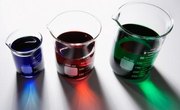
You can measure the pH of a substance several ways. A pH meter is one of the most common methods, and pH paper (also known as litmus paper or pH strips) is also a quick way. Other methods include titration, but it is tedious and requires detailed hands-on work. Read on to learn more about a comparison of pH detection methods.
The pH Meter
In 1908, Fritz Haber and Zygmunt Klemensiewicz made the first glass pH electrode. A year later, they published the paper describing the electrode, so it is usually assumed that the electrode creation date was 1909. A pH meter has a membrane that allows acidic ions (H+) to pass through it creating a voltage. The meter associates each voltage with a particular pH value. The higher the concentration of acid, the more ions that will pass through the membrane, thereby changing the voltage. This voltage change results in a higher pH value.
The Litmus Paper
"It doesn't pass the litmus test" is a common phrase that has its origin in the use of litmus paper for pH detection. These strips of paper have pH indicator molecules that change color upon contact with solution of a particular pH. Each color is indicative of a particular pH value. You can compare the paper to a standard chart where the colors show different pH values.
Accuracy of the pH meter
A pH meter usually has a computer or a digital user interface. You can calibrate it by using standardized buffers which allow the meter to associate a particular voltage with a pH value. There are subtle differences between pH meters, but they are generally accurate at least to the hundredths place. These meters can be sensitive to ion interference, from various ions in the solution you are testing, and may drift from their calibrated position after some time. As long as you treat them with care, calibrate them regularly, maintain them according to the manufacturer's recommendation, and store them correctly, you can expect a pH meter to be accurate and durable.
Accuracy of pH paper
The use of pH paper is similar to the use of a Galileo thermometer. Particular colors indicate certain values, and each measurement is only accurate within a unit or two. While pH paper is great for quick qualitative work, it fails at highly accurate quantitative work. If the accuracy you desire is within one pH value or two, paper is the way to go. Litmus paper can give you a quick check to see if your solution is acidic, neutral or basic. That is one place pH paper shines. On a side note, pH paper will be difficult to work with accurately if you are color blind.
Other Things to Consider
When you are doing a comparison of pH detection methods, it is important to think about your space. If size and bench spaces are a concern, pH papers come in a small canister which is no bigger than a bottle of prescription pills. Meters on the other hand can take up space about the size of a laptop computer, and some can reach into the air about a foot and a half. Cost is always an issue to consider. Litmus paper will cost you about $10 while an electronic pH meter can cost between $50 and $800.
References
About the Author
Philip J. Carlson is currently a Ph.D. candidate in the department of chemistry at Iowa State University. He earned a B.S. degree (cum laude) with majors in chemistry and mathematics. Carlson also has a B.A. in evangelism and missions, and an A.S. degree in chemistry. He has published in a number of peer-reviewed journals and even has a pending patent.
